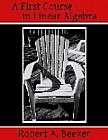- About MAA
- Membership
- MAA Publications
- Periodicals
- Blogs
- MAA Book Series
- MAA Press (an imprint of the AMS)
- MAA Notes
- MAA Reviews
- Mathematical Communication
- Information for Libraries
- Author Resources
- Advertise with MAA
- Meetings
- Competitions
- Programs
- Communities
- MAA Sections
- SIGMAA
- MAA Connect
- Students
- MAA Awards
- Awards Booklets
- Writing Awards
- Teaching Awards
- Service Awards
- Research Awards
- Lecture Awards
- Putnam Competition Individual and Team Winners
- D. E. Shaw Group AMC 8 Awards & Certificates
- Maryam Mirzakhani AMC 10 A Awards & Certificates
- Two Sigma AMC 10 B Awards & Certificates
- Jane Street AMC 12 A Awards & Certificates
- Akamai AMC 12 B Awards & Certificates
- High School Teachers
- News
You are here
A First Course in Linear Algebra

Publisher:
Robert Beezer
Publication Date:
2011
Number of Pages:
1036
Format:
Electronic Book
Price:
0.00
ISBN:
open source text
Category:
Textbook
[Reviewed by , on ]
Mike Daven and Tanya Leise
08/26/2011
Robert Beezer’s free textbook A First Course in Linear Algebra (FCLA) is an excellent textbook. FCLA includes all of the major and requisite topics plus a nice selection of optional topics, and Beezer’s style of writing is friendly and enlightening. There are a large number of examples and exercises, many with answers provided, although some sections lack sufficient exercises covering basic concepts. No calculus is required, but FCLA should be used in a linear algebra course given at the end of the calculus sequence so that the students have some experience with formal mathematical writing. Also, FCLA does not rely on any particular computer algebra system, but computation notes for Mathematica and Sage are included at the end of the text to assist those who wish to use them in their courses, and a Sage-enhanced textbook is now available.
A great advantage of this textbook is the price. It is free for students who use an electronic form (download from http://linear.ups.edu/) and inexpensive for those who want a printed copy, e.g., through Lulu.com (keeping a printed copy or two on reserve to supplement students’ use of the electronic version is a very cost-effective approach). FCLA is also available for the Amazon Kindle and SONY Reader; there is a version for on-screen viewing in class.
Another unusual and wonderful feature is that the text really is “open source.” It can be modified to suit the instructor’s desired ordering and selection of topics: just revise the source TeX file, which is also available on the FCLA website.
The flip side of this open source flexibility is that the FCLA looks rather plain, especially to students used to the glossy multicolor textbooks commonly used in the calculus sequence. The prose is not as polished as what one sees in published textbooks overseen by diligent editors. Countering this minor fault is the hyperlinked format offered by the electronic versions, in which students can click on a mathematics term to jump back to the definition or click on a theorem reference to jump back to its statement.
Throughout the book, Beezer makes repeated use of a large set of problems that he calls “Archetypes.” They appear in many of the examples and exercises. As students progress through the book, they will see how the major ideas proceed from the basic computations that were studied earlier in the semester. Students see how the archetypes develop from a system of linear equations to an augmented matrix and then to a reduced row-echelon matrix. Later they explore how the archetypes become part of a homogeneous system of equations, how the reduced matrix they found earlier leads to a basis for the null space, and so on. A benefit of this approach is that considerably less time is spent doing tedious calculations or computations as we build up to the big ideas.
Acronyms are used for chapters, sections, theorem, examples, and exercises, rather than a traditional numbering system. For instance, the book begins with Chapter SLE (Systems of Linear Equations). The title seems a bit awkward, but most readers quickly adjust to this approach. The links and easy searchability of the electronic version make the text quite convenient to use.
The text offers few applications, so some supplements may be needed for a “linear algebra with applications” course (TL has used the text for such a course, quite successfully). The early introduction of inner products, norms, and orthogonality facilitates the inclusion of applications such as least squares.
Overall, while FCLA is not as polished as the popular texts from the major publishers, FCLA offers a very affordable and good quality alternative. We have both used it in our linear algebra courses and highly recommend it.
Mike Daven teaches mathematics at Mount Saint Mary College. His background is in discrete mathematics and many of his students are future K-12 teachers. Tanya Leise teaches mathematics at Amherst College, with a strong slant to the applied side, including the study of biological clocks.
(See http://linear.ups.edu/ for more details)
Chapter SLE Systems of Linear Equations
Chapter V Vectors
Chapter M Matrices
Chapter VS Vector Spaces
Chapter D Determinants
Chapter E Eigenvalues
Chapter LT Linear Transformations
Chapter R Representations
Chapter MD Matrix Decompositions
Appendix CN Computation Notes
Appendix P Preliminaries
Appendix GFDL GNU Free Documentation License
- Log in to post comments




